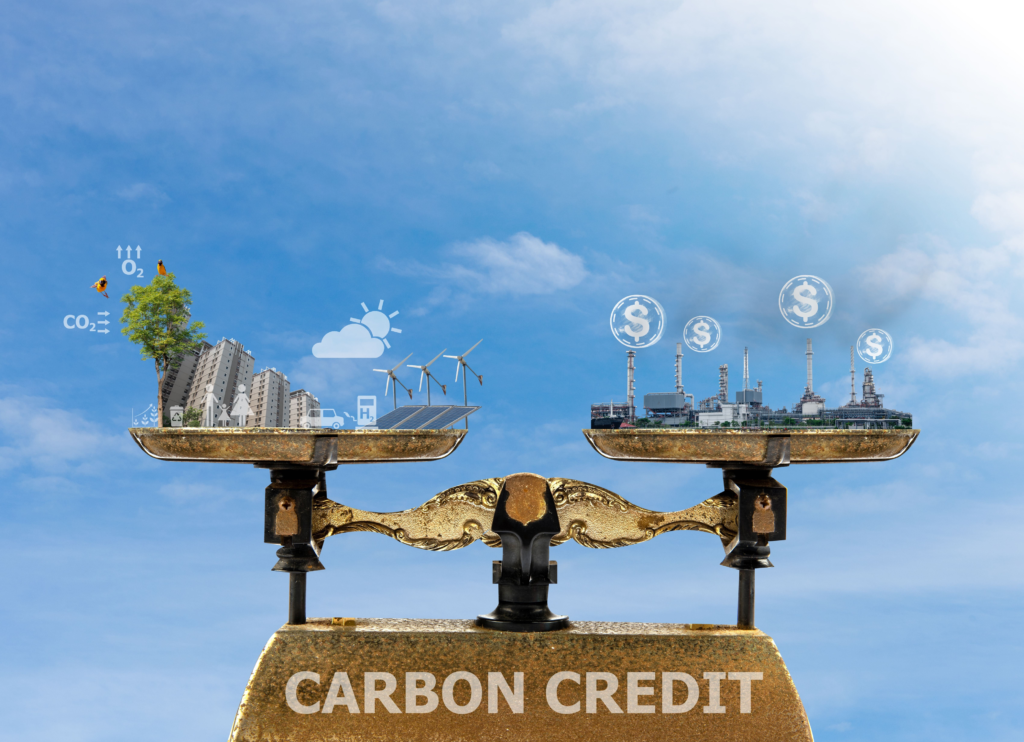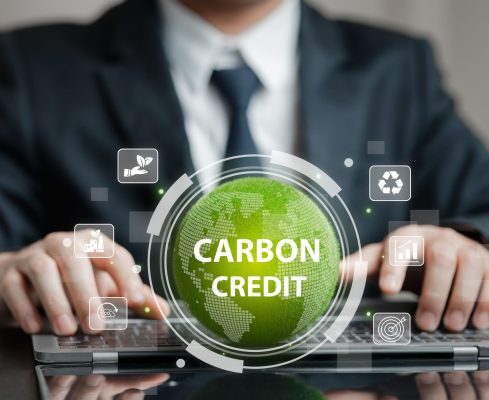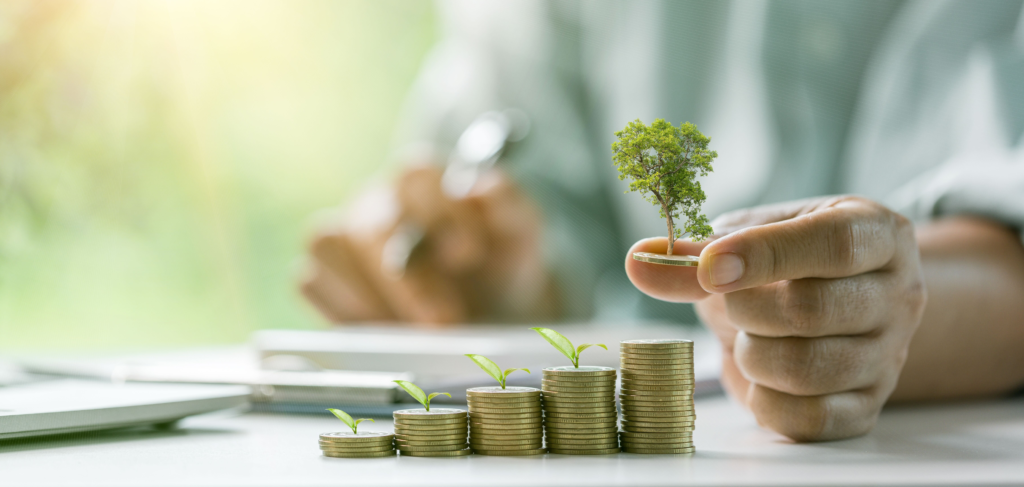
Investor Insights
March 2025
How the UAE’s Carbon Credit Market Unlocks Sustainable Investment Opportunities
In today’s world, the carbon credit market plays a pivotal role in combating climate change and promoting sustainable development. As global temperatures rise and environmental degradation accelerates, nations and corporations are under increasing pressure to reduce greenhouse gas emissions.
Firstly, what is a carbon credit? Carbon credits are measurable, verifiable emission reductions from certified climate action projects. These projects reduce, remove, or avoid greenhouse gas (GHG) emissions.

Carbon credits provide a market-based mechanism to incentivize emission reductions, allowing entities to offset their carbon footprint by investing in eco-friendly projects. This system not only fosters innovation in clean technologies but also channels funds into renewable energy, reforestation, and energy efficiency initiatives. Amid tightening regulations and growing environmental awareness, the carbon credit market has become indispensable for achieving net-zero goals. The UAE’s carbon credit market is poised for transformation following the introduction of Cabinet Resolution No. 67 of 2024, which established the National Register of Carbon Credits (NRCC). Effective from December 28, 2024, with compliance required by June 28, 2025, this legislation is a key step in aligning the UAE’s sustainability ambitions with international carbon trading frameworks. It reinforces the UAE’s commitment to achieving climate neutrality by 2050 while positioning the country as a leader in the global carbon market. The NRCC treats carbon credits as financial instruments, allowing regulated trading in the emirates.
Scope of the Resolution and Compliance Requirements
The Resolution mandates carbon credit regulation across both public and private sectors, covering onshore and offshore entities. It primarily targets:
1. Entities with substantial carbon emissions-those emitting 0.5 million metric tons of CO₂ equivalent or more annually. The UAE government retains the authority to expand the scope of the resolution, incorporating additional sectors or lowering the emission threshold in the future.
2. Participating entities organizations voluntarily reducing emissions below the threshold, allowing them to register with the NRCC and trade carbon credits.
3. Trading platforms-entities facilitating carbon credit exchanges under regulatory oversight.
Ensuring Compliance: Entities must comply with two key regulatory measures:
• Registration with the NRCC
• High-emission entities are required to register, while voluntary participants may opt to register.
• Reporting obligations include annual emissions statements and detailed records of carbon credit transactions (quantity, buyer/seller details, and pricing).
• Monitoring, Reporting, and Verification (MRV) Systems
• Companies must establish robust MRV systems to track and report annual emissions to the Ministry of Climate Change and Environment (MOCCAE).
• Reports must cover various GHG emissions (CO₂, methane, nitrous oxide, etc.).
• Non-compliance may result in fines up to AED 1 million, license suspensions, or cancellations as well as revocation of trading platform licenses.
Article 6 and Its Impact on the UAE Carbon Credit Market
Article 6 of the Paris Agreement establishes a framework for international carbon trading, enabling nations to collaborate in meeting their emissions reduction commitments. The agreements reached at COP29 on Articles 6.2 and 6.4 signal a strong endorsement of carbon markets as a tool for global decarbonization. This is particularly relevant for the UAE, which has been positioning itself as a regional leader in sustainability, climate finance, and carbon trading.
The Role of Article 6 in Carbon Trading
Article 6.2 (A6.2) facilitates the transfer of Internationally Transferred Mitigation Outcomes (ITMOs), allowing countries to finance emissions reduction projects in other nations and count those reductions toward their own targets. This presents an opportunity for the UAE to engage in bilateral agreements, securing carbon credits from sustainable projects in developing markets while reinforcing its net-zero commitments. Article 6.4 (A6.4) establishes the Paris Agreement Crediting Mechanism (PACM), a UN supervised global carbon market. The PACM introduces a structured system where projects can apply to issue Article 6.4-aligned credits (A6.4ERs), expected to be available by early 2025. This mechanism is poised to enhance transparency and credibility in carbon trading, ensuring that emissions reductions are properly accounted for and not double counted.

Implications for the UAE Carbon Market
The UAE has been actively developing its carbon market infrastructure, recognizing the economic and environmental benefits of emissions trading. With the establishment of the PACM, the country could see several key developments:
1. Growth of a Regional Carbon Hub: The UAE has already demonstrated its commitment to becoming a leader in carbon trading. The adoption of Article 6 mechanisms could position the UAE as a major hub for carbon transactions in the Middle East, attracting both domestic and international investors.
2. New Opportunities for Businesses: The PACM introduces a higher standard for carbon credits, which will likely influence corporate sustainability strategies in the UAE. Businesses operating in sectors with high emissions such as aviation, energy, and heavy industry—will need to reassess their carbon credit portfolios, shifting towards high-integrity credits that align with A6.4 standards.
3. Increased Climate Finance and Investment: By leveraging Article 6 mechanisms, the country can channel investments into emissions reduction projects across Africa and Asia, aligning with its broader sustainability and foreign policy goals.
4. Enhanced Corporate Accountability: With PACM setting a minimum quality standard for carbon credits, companies in the UAE will need to be more transparent in their carbon offset strategies. Buyers will face greater scrutiny regarding the integrity of the credits they purchase, which could drive a shift toward more rigorous carbon accounting practices.
Business Opportunities in the UAE’s Carbon Credit System
• Revenue Generation through Carbon Trading: Companies with surplus carbon credits can monetize their reductions by selling them on regulated platforms.
• Incentives for Emission Reductions: Investments in renewable energy, carbon capture, and sustainability initiatives can yield valuable carbon credits, offering both financial and environmental benefits.
• Integration with Global Carbon Markets: The UAE’s system is designed to align with international trading mechanisms, enabling businesses to seamlessly participate in global sustainability initiatives.
• Competitive ESG Advantage: Companies that adopt carbon neutrality strategies can enhance their ESG ratings, attract sustainability-focused investors, and strengthen their market positioning.

Path to Progress: Pioneering Blockchain in Carbon Markets
Enter a European company that won the COP28 UAE TechSprint for “Innovative Blockchain Solutions in Sustainable Finance to Scale Up Climate Action” with its blockchain-powered platform for issuing, trading, clearing, and settlement of carbon credits linked to ESG assets.
With seamless interoperability across APIs and blockchains, the platform is a key enabler of global climate finance and sustainability. As a Platform as-a-Service, it provides a decentralized entry point for digital issuance and settlement of carbon credits and ESG securities. By integrating multiple carbon exchanges, registries, and custodians, it ensures transparent pricing, real-time settlement, and verified supply using blockchain and API connectivity.
Inside the Solution: Revolutionizing Carbon Credit Trading
1. Acts as a decentralized hub, linking multiple stakeholders carbon exchanges, registries, custodians, ESG project owners, buyers, sellers, banks, and climate tech/fintech firms into a cohesive “Network of Networks.” This addresses fragmentation in carbon markets by providing a distributed entry point for digital issuance, trading, and settlement of carbon credits and ESG assets.
2. Its interoperability across various blockchains (public and private) and APIs ensures seamless connectivity, reducing silos and enhancing market efficiency.
3. Tackles persistent issues like greenwashing, double counting, and lack of price transparency by leveraging AI for real-time measurement and validation and blockchain for immutable record-keeping. This ensures carbon credits are credible, traceable, and verifiable, fostering trust among participants.

4. The platform integrates digital Monitoring, Reporting, and Verification (dMRV) systems, aligning with international standards to provide high-integrity carbon credits.
5. The platform enables efficient trading, exchange matching, and real-time settlement of both traditional and digital carbon credits, as well as other ESG assets. It uses Pyctor technology to power the Chain, a multi-blockchain settlement mechanism that optimizes Delivery versus Payment (DvP) contracts.
6. Bridges climate tech and fintech, aiming to close the multi-trillion-dollar climate financing gap. One of its partnerships, announced at the 2024 Davos World Economic Forum, targets $100 billion in capital market investment into high-integrity carbon credits by mobilizing funds for renewable energy and regenerative agriculture projects.
Why Invest In The Company: Signals of Success to Monitor
Technological Innovation: The platform’s use of AI and blockchain ensures transparency and scalability. For instance, its hybrid approach blends multiple blockchain networks (e.g., Cosmos, with a low carbon footprint) and APIs, creating a robust infrastructure for carbon credit management.
• Global Reach: It operates across countries like Ghana, Seychelles, and Singapore, with access to over $1 billion in bankable projects and over 100 million of high integrity carbon credits as of January 2025, enhancing economic development and community benefits in the Global South.
• Sustainability Integration: Beyond carbon credits, the platform supports ESG assets, such as tokenized renewable energy projects, aligning with broader sustainability goals like UN SDG 13 (Climate Action).
• Enhanced trust through automated verification, preventing double counting and greenwashing.
• Streamlined trading and settlement workflows by reducing intermediaries, ensuring price transparency, integrating silos, and aggregating carbon markets.
• A market-driven approach tailored to the needs of industrial operators, corporations, and institutional investors.
Drive the Market, Be the Change
The UAE’s carbon credit market is poised to become a key driver of sustainability and economic opportunity. By implementing NRCC, the UAE has established a transparent framework that incentivizes emission reductions while creating a structured marketplace for carbon trading. Businesses that proactively engage with this system whether by mitigating their emissions, trading carbon credits, or aligning with evolving compliance requirements-stand to benefit not only from regulatory adherence but also from enhanced corporate reputation and financial opportunities.
Collaboration Opportunity
We invite you to join forces with this award-winning firm as we embark on an ambitious growth journey fueled by innovation and strategic expansion. We are actively seeking collaborative opportunities, particularly in equity investment, to accelerate our vision. Partnering with us means not only contributing to our success but also unlocking potential returns in the UAE’s burgeoning carbon credit market. Let’s explore how your investment can align with this forward-thinking strategy and drive mutual growth. The future is brimming with possibilities-let’s seize them together.


 and reforestation to deliver results that are in line with the UN Sustainable Development Goals. It specializes in giving clients advice on energy efficiency, clean energy options, tr
and reforestation to deliver results that are in line with the UN Sustainable Development Goals. It specializes in giving clients advice on energy efficiency, clean energy options, tr carbon market participants into a global ecosystem for financial and environmental gains, with a focus on energy, water, and food. It serves as a distributed hub and connective tissue to link multiple international carbon exchanges and other buyside carbon emitters and custodians with supply-side carbon offset projects and ESG project owners globally to drive distribution. For the purpose of keeping carbon credit ledger data up to date, their software also communicates with reputable third-party registries.
carbon market participants into a global ecosystem for financial and environmental gains, with a focus on energy, water, and food. It serves as a distributed hub and connective tissue to link multiple international carbon exchanges and other buyside carbon emitters and custodians with supply-side carbon offset projects and ESG project owners globally to drive distribution. For the purpose of keeping carbon credit ledger data up to date, their software also communicates with reputable third-party registries. The firm’s platform matches investors with advanced learners by exploiting the fully scalable and high-return potential of non-loan Income Share Agreements (ISA’s). Investors in ISA’s may finely tune their investment criteria to match their corporate objectives, which may include CSR targets. Currently, the firm is proposing two types of investment opportunity: in the infinite possibilities of direct investments in ISA’s and, more conventionally, investments in shares (and, as the firm is designated by the French state as an innovative firm, offers the possibility of French residency/citizenship).
The firm’s platform matches investors with advanced learners by exploiting the fully scalable and high-return potential of non-loan Income Share Agreements (ISA’s). Investors in ISA’s may finely tune their investment criteria to match their corporate objectives, which may include CSR targets. Currently, the firm is proposing two types of investment opportunity: in the infinite possibilities of direct investments in ISA’s and, more conventionally, investments in shares (and, as the firm is designated by the French state as an innovative firm, offers the possibility of French residency/citizenship). After a year of service, the e-ferry’s operators concluded that the system has a highly sustainable energy efficiency of 85%, almost twice that of diesel boats. With this background, the US$20 billion market expectation for electric watercraft seems more than reasonable. To support this industry, we are following a firm that has designed, and begun delivering, an electric-powered watercraft. Destined for the lucrative leisure market, this is a mere stepping stone to the huge water taxi market for which a design is already complete.
After a year of service, the e-ferry’s operators concluded that the system has a highly sustainable energy efficiency of 85%, almost twice that of diesel boats. With this background, the US$20 billion market expectation for electric watercraft seems more than reasonable. To support this industry, we are following a firm that has designed, and begun delivering, an electric-powered watercraft. Destined for the lucrative leisure market, this is a mere stepping stone to the huge water taxi market for which a design is already complete. technology that detects one of the deadliest types of cancer and treats it without damaging healthy cells and tissues. Its electromagnetic stimulation, combined with a nanotechnology system, has demonstrated the preclinical treatment to be safe and effective. The medical device has been classified as class III to chronically treat and reduce cancer’s mass significantly from further development. The firm has started Phase I and seeking investments to support this phase. Based on Phase I results, which will be within 12-15 months, they plan an IPO for Phase II, the last one before the commercial launch in North America by 2024.
technology that detects one of the deadliest types of cancer and treats it without damaging healthy cells and tissues. Its electromagnetic stimulation, combined with a nanotechnology system, has demonstrated the preclinical treatment to be safe and effective. The medical device has been classified as class III to chronically treat and reduce cancer’s mass significantly from further development. The firm has started Phase I and seeking investments to support this phase. Based on Phase I results, which will be within 12-15 months, they plan an IPO for Phase II, the last one before the commercial launch in North America by 2024.





































